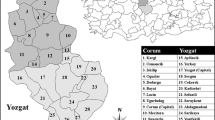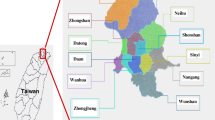Abstract
Ticks of the Ixodidae family represent an enormous threat to human and animal health. From January to December 2004, a total of 10,050 ixodid ticks were collected from 26 areas in Bosnia and Herzegovina and determined to the species level. Ticks were collected from dogs, sheep, cows, goats, rodents, humans and plants. Ixodes ricinus was the most prevalent species, followed by Dermacentor marginatus marginatus, Rhipicephalus bursa, Hyalomma marginatum marginatum, Rhipicephalus sanguineus, Haemaphysalis punctata, Dermacentor reticulatus and Ixodes hexagonus.



Similar content being viewed by others
References
Apfelbeck V (1927) Contribution to the introduction to Ixodida fauna in Bosnia and Herzegovina and neighboring regions. Glas CHZ 3:176–195
Barbetti KM (1943) Ticks from southern Croatia with special regard to genus Boophilus (Curtice 1891). Vet arhiv 13(9):358–379
Bjelica G (1964) Sheep parasites in the Konjic municipality and some conditions for their occurrence and spread. PhD Thesis, Vetrerinary Faculty, Universitiy of Sarajevo, B&H
Bowman AS, Nuttall PA (2004) Ticks: biology, disease and control. Parasitology, 129
Bram RA (1978) Surveillance and Collection of Arthropods of Veterinary Importance. First edition, United States Department of Agriculture, Agriculture Handbook, 518: 102-113, Washington DC
Cumming GS (1999) The Evolutionary Ecology of African Ticks. PhD Thesis, Faculty of Biological Sciences, University of Oxford, UK
Cvjetanović V (1956) On the species, distribution and seasonal incidences of ticks in Dalmatia with the reference to the occurrence of tick-paralysis. Veterinaria 2–3:589–595
Daniel M, Danielova V, Kriz B, Jirsa A, Nozicka J (2003) Shift of the tick Ixodes ricinus and tick-borne encephalitis to higher altitudes in cntral Europe. Eur J Clin Microbiol 22:327–328
Daniel M, Danielova V, Kriz B, Kott I (2004) An attempt to elucidate thr increased incidence of tick-borne encephalitis and its spread to higher altitudes in central Europe. Int J Med Microbiol 293(37):55–62
Delić S, Petrović Z, Rukavina J (1958) Contribution to the knowledge on the incidence of ticks in Bosnia and Hercegovina. Veterinaria 7(2):297–316
Estrada-Pena A (2002) Ixodoidea (Acarina) de la Peninsula Iberica. Virbac Laboratories, VP99702, Zaragoza, Spain
Estrada-Pena A, Jongejan F (1999) Ticks Feeding on Humans: A Review of Record on Human-Biting Ixodoidea with Special Reference to Pathogen Transmission. Exp Appl Acarol 23(9):685–715
Estrada-Pena A, Bouattour A, Camicas JL, Walker AR (2004) Ticks of Domestic Animals in the Mediterranean Region: a Guide to Identification of Species. University of Zaragoza, Zaragoza, Spain
Gray JS (2008) Ixodes ricinus seasonal activity: implications of global warming indicated by revisiting tick and weather data. Int J Med Microbiol 298(supplement 1):19–24
Gray JS, Dautel H, Estrada-Pena A, Kahl O, Lindgren E (2009) Effects of climate change on ticks and tick-borne diseases in Europe. Interdisciplinary perspectives on infectious diseases, Hindawi Publishing Corporation, 2009, ID 593232 p 12
Inchiostri H (1921) Piroplasmosa ovis in Dalmatia. Clin Vet 44:447–454
Lindgren E, Talleklint L, Polfeldt T (2000) Impact of climatic change on the northern latitude limit and population density of the disease–transmitting European tick Ixodes ricinus. Environ Health Perspect 108(2):119–123
Mannila G (1998) Fauna d, Italia. Acari: Ixodida. Edizioni Calderoni Bologna, Italy
Mehlhorn H (1988) Parasitology in Focus: Facts and Trends. Springer-Verlag GmbH & Co. KG, Berlin, Germany
Mikačić D (1969) Dynamics in occurrence of ticks (Ixodidae) in the northern part of Croatia. Vet arhiv 39(7–8):183–186
Muftić IR (1965) Iksodida fauna in cattle and sheep in northwestern Bosnia. (Geographical location and seasonal dynamics of some species). PhD thesis, Veterinary Faculty of Sarajevo, University of Sarajevo, B&H
Omeragić J (2008) Investigation of ticks of the Ixodidae family in Bosnia and Herzegovina, PhD thesis, Veterinary Faculty of Sarajevo, University of Sarajevo, B&H
Omeragić J, Jažić A, Zuko A (2003) Parasites of dogs and cats in area of Bosnia and Herzegovina founded to 2002. Veterinaria, 52 (1-4):157-164, Sarajevo, B&H
Oswald B (1938) The species, occurrence and distribution of ticks in Yugoslavia, with special reference to southern Serbia. Jugoslavenski Vet Glas 2:54
Pomerancev BI (1950) Paukoobraznie. Ixsodovnjie kleščei (Ixodidae) Fauna SSSR., IV, 2, 3, Moskva—Leningrad, Russia
Sonenshine DE (1991) Biology of Ticks, vol 1–2. Oxford University Press, New York
Statistical review of the Federation of Bosnia and Herzegovina (2008) Published and printed by the Federal Office of Statistics, Sarajevo, B&H
Talleklint L, Jaenson TG (1998) Increasing geographical distribution and density of Ixodes ricinus (Acari: Ixodidae) in central and northern Sweden. J Med Entomol 35(4):521–526
Zlobin VI, Adeljšin RA, Golubović S, Tešanović M, Verhozina MM, Kozlova IV, Belikov SI (2006) Molecular epidemiology of tick-borne encephalitis virus. Naučne medicinske komunikacije, II, 12, Banja Luka, B&H pp 11–14
Zuko A (1998) Parasites and parasitoses in ruminants in upland regions of Bosnia and Herzegovina. PhD Thesis, Sarajevo, B&H
Acknowledgments
I would like to thank Prof. Dr. Almedina Zuko, Dean of Veterinary faculty of Sarajevo and many of my B&H colleagues, as without their help this work would not have been possible. Furthermore, I wish to thank Prof. Dr. Kurt Pfister, Head of Institute for Compparative Tropical Medicine and Parasitology, Faculty of Veterinary Medicine Munich, Germany for his kind support required to complete this project and his staff for their help in the fulfillment of the work.
Author information
Authors and Affiliations
Corresponding author
Rights and permissions
About this article
Cite this article
Omeragic, J. Ixodid ticks in Bosnia and Herzegovina. Exp Appl Acarol 53, 301–309 (2011). https://doi.org/10.1007/s10493-010-9402-8
Received:
Accepted:
Published:
Issue Date:
DOI: https://doi.org/10.1007/s10493-010-9402-8




